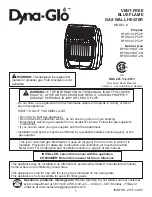
12
.
Gas odor with extreme yellow tipping of flame.
.
Heater does NOT reach the desired temperature.
.
Heater glow is excessively uneven.
.
Heater makes popping noises.
Ґ
.
Spiders and insects can nest in burner or orifices.
This dangerous condition can damage heater and
render it unsafe for use. Clean burner holes by using
a heavy-duty pipe cleaner. Compressed air may help
clear away smaller particles.
.
Carbon deposits may create a fire hazard. Clean
dome and burner screen with warm soapy water if
any carbon deposits develop.
Note: In a salt-air environment (such as near an ocean),
corrosion occurs more quickly than normal. Frequently
check for corroded areas and repair them promptly.
TIP:
Use high-quality automobile wax to help maintain the
appearance of your heater. Apply to exterior surfaces from
the pole down. Do not apply to emitter screen or domes.
Storage
Between uses:
.
Turn Control Knob OFF.
.
Disconnect
LP
source.
.
Store heater upright in an area sheltered from direct
contact with inclement weather (such as rain, sleet,
hail, snow, dust and debris).
.
If desired, cover heater to protect exterior surfaces
and to help prevent build up in air passages.
Note: Wait until heater is cool before covering.
During periods of extended inactivity or when
transporting:
.
Turn Control Knob OFF.
.
Disconnect LP source and move to a secure,
well-ventilated location outdoors.
.
Store heater upright in an area sheltered from direct
contact with inclement weather (such as rain, sleet,
hail, snow, dust and debris).
.
If desired, cover heater to protect exterior surfaces
and to help prevent build up in air passages.
.
Never leave LP cylinder exposed to direct sunlight or
excessive heat.
Note: Wait until heater is cool before covering.
Service
Repair to gas passages and associated components
should be done only by a qualified service person.
Caution: Always allow heater to cool before
attempting service.
































